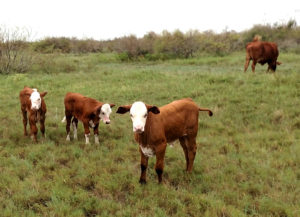Improper mosquito control on livestock can do more harm than good, expert warns
Writer: Steve Byrns, 325-653-4576, [email protected]
Contacts: Dr. Sonja Swiger, 254-968-4144, [email protected]
Dr. Joe Paschal, 361-265-9203, [email protected]
STEPHENVILLE — In an effort to save their livestock from the torment caused by the plague of mosquitoes in the wake of Hurricane Harvey, some producers are making the mistake of misusing chemicals to control the pests, said a Texas A&M AgriLife Extension Service expert.
“The results can be potentially disastrous,” said Dr. Sonja Swiger, AgriLife Extension livestock entomologist at Stephenville. “Misuse of potent chemicals can quickly become an example of ‘the cure is worse than the malady,’ not only for the animals being treated but also to the environment.
“I have heard people promoting the use of premise treatment products for mosquito control on their cattle,” she said. “They’re reportedly using pyrethroid chemicals that are labeled ‘NOT FOR USE ON ANIMALS’ on their cattle. I can’t emphasize enough how important it is to follow the label, even if it’s 10 pages long. What a tragedy it could be if producers whose animals survived the storm lost them through their own wrongdoing.”
Dr. Joe Paschal, AgriLife Extension livestock specialist at Corpus Christi, said he’s also heard reports of off-label pesticide use by some in the affected area.

“One recommendation was a product I had not heard of,” he said. “I looked it up and it turned out to be a termiticide, which of course was not approved for livestock, only premises.”
Swiger said the all-important chemical label specifically defines how a product should and can be used.
“Products that are labeled ‘not for animal use’ are not at the proper application rate for the animals or worse, shouldn’t be used on animals at all,” she said. “Applying them to livestock could have a negative impact on the animals such as skin issues, retention in the meat or even death.”
There are products available that are labeled for on-animal use. Most are permethrins or other pyrethroids but the labeling will say specifically how to treat the animals, she said.
Swiger concedes the current demand and logistical problems following Hurricane Harvey have made livestock pesticides harder to find than normal, but they are available.
“In a disaster situation people might feel using anything is better than using nothing, but this is of course not a smart idea. If the products are not on hand, then make the effort to get the right products.”
What happens if producers do nothing? Swiger said not helping to suppress the mosquito populations feeding on one’s cattle could also be detrimental.
“Most older cows can withstand the extensive bites and large numbers reported, but they should not have to,” she said. “Calves and heifers are more susceptible and can suffer from anemia due to blood loss or even asphyxiation due to the large mosquito populations. Keep in mind that one female mosquito can lay an average of 200 eggs and at least half will be female. All will emerge at one time, so there could be hundreds to thousands of mosquitoes looking for blood at the same time. And since these mosquitoes grow in uninhabited locations most of the time, cattle and wildlife are their first hosts.”
Paschal said the main immediate problems when confronted by massive numbers of the pests are inhaling and ingesting mosquitoes, especially by young calves.
“Hard as it is to believe under normal circumstances, asphyxiation – choking and death – can and does occur following events such as Hurricane Harvey,” Paschal said. “Besides the hazards to young calves that have already been pretty well stressed from the storm, mosquitoes can transmit parasites and diseases to other animals — such as heartworms to dogs, the encephalopathies and equine infectious anemia to equines, and of course, numerous human maladies.
For more information, go to: http://livestockvetento.tamu.edu .


